Being a car owner comes with responsibilities, and one of the most important is proactive maintenance. Understanding the mechanical parts of your car empowers you to make informed decisions about repairs and upkeep. Knowing the essential components, from the engine to the wheels, is not just for mechanics; it’s for every driver who wants to ensure their vehicle runs smoothly and safely.
It’s crucial to be aware of car parts that can be dangerous if they malfunction and those that are relatively inexpensive to maintain. This knowledge helps you prioritize maintenance, ensuring both your safety and the longevity of your vehicle.
Understanding your car’s parts is key to proper maintenance and managing associated costs.
Let’s delve into the anatomy of a car, exploring the key components that make up this complex machine.
Decoding Engine Components
Maintaining your engine is crucial for preserving your car’s value and minimizing running costs.
The engine is the heart of your car, and several key parts work in harmony to generate power.
Cylinder Block and Pistons: The Powerhouse
The cylinder block is the foundational structure of the engine, housing the cylinders. These cylinders are hollow tubes where combustion occurs. Inside these cylinders, pistons move up and down, driven by the force of combustion. This motion is essential for converting the energy from burning fuel into mechanical power, which ultimately propels your car. The interaction between pistons and cylinders is the core of your car’s power generation.
Crankshaft and Camshaft: Orchestrating Motion
Deep within the engine, the crankshaft and camshaft are vital for its operation. The crankshaft converts the linear, up-and-down motion of the pistons into rotational motion, providing the driving force to the wheels. Simultaneously, the camshaft precisely controls the timing of the engine valves, ensuring that intake and exhaust processes are synchronized for efficient combustion. Together, these components orchestrate the internal combustion process, resulting in the smooth and powerful movement of your vehicle.
Intake and Exhaust Manifolds: The Breathing System
Think of the intake and exhaust manifolds as the lungs of your car. The intake manifold is responsible for drawing air into the engine cylinders, providing the oxygen needed for combustion. Conversely, the exhaust manifold expels the gases produced after combustion, directing them out through the exhaust system. These manifolds are critical for optimizing engine performance by ensuring a balanced and efficient flow of air and exhaust gases. It’s important to note that electric vehicles do not have intake and exhaust manifolds as they operate without internal combustion engines.
Powertrain and Gearboxes Explained
The gearbox, a critical part of manual cars, requires smooth operation and careful handling.
The powertrain is the system that transmits power from the engine to the wheels, and gearboxes (transmissions) are a crucial part of this system.
Understanding Different Types of Gearboxes (Transmissions)
The gearbox, or transmission, is responsible for managing the engine’s power and delivering it effectively to the wheels. Different types offer varied driving experiences:
Manual Gearboxes: Driver Control
Manual gearboxes provide drivers with complete control over gear selection. They require the driver to manually engage and disengage gears using a clutch pedal and gear stick. This type of gearbox allows for precise control in varying driving conditions, such as adjusting to slippery roads or optimizing for acceleration or deceleration. Manual transmissions are favored by drivers who enjoy a more engaged and interactive driving experience.
Automatic Gearboxes: Smooth and Effortless
Automatic gearboxes simplify driving by automatically shifting gears without driver intervention. This seamless gear changing is achieved without the need for a clutch pedal or manual gear lever operation. A key component within automatic transmissions is the torque converter, a fluid coupling mechanism that ensures smooth gear transitions and power delivery. Automatic transmissions offer convenience and ease of driving, particularly in stop-and-go traffic.
Continuously Variable Transmissions (CVTs): Advanced Efficiency
Continuously Variable Transmissions (CVTs) represent a sophisticated approach to gearbox mechanics. CVTs utilize a system of pulleys and belts to offer an infinite range of gear ratios. This design results in exceptionally smooth and continuous acceleration, eliminating the gear shifts felt in traditional automatic transmissions. CVTs are designed to maximize fuel efficiency and dynamically adapt to changing driving conditions, making them a high-performance and economical choice.
Differential and Driveshaft: Distributing Power
In the powertrain system, the differential and driveshaft play distinct but complementary roles. The driveshaft is responsible for transferring power generated by the engine and gearbox to the wheels. The differential, on the other hand, ensures that power is distributed evenly to the wheels, especially when turning. This even distribution is crucial for smooth cornering and prevents wheel slippage. Together, the driveshaft and differential create a balanced system for effective vehicle motion and handling.
Clutch and Torque Converter: Engaging the Gears
Within the transmission system, the clutch and torque converter are essential for managing power flow. In manual transmissions, the clutch allows the driver to engage and disengage the engine from the gearbox, enabling gear changes and precise control over power delivery. In automatic transmissions, the torque converter smoothly transfers engine power to the transmission, facilitating seamless gear shifts and a dynamic driving experience. Both components are vital for smooth and efficient vehicle operation, each suited to their respective transmission types.
Fuel and Ignition Systems: Powering Combustion
A properly functioning fuel system is crucial for avoiding breakdowns in internal combustion engine cars.
The fuel and ignition systems are responsible for delivering fuel to the engine and igniting it to create power.
Fuel Injection System: Precision Fuel Delivery
The fuel injection system is a critical component in modern engines, designed to optimize combustion efficiency. Fuel injectors precisely spray fuel into the engine cylinders in a fine mist. This precise delivery enhances engine power, improves fuel economy, and reduces emissions compared to older carburettor systems. Fuel injection systems replaced carburettors, which were prone to issues like clogging. Modern fuel injection offers superior fuel distribution, leading to enhanced engine performance and environmental benefits.
Spark Plugs and Ignition Coils: Initiating Combustion
The ignition system, comprising spark plugs and ignition coils, is essential for starting the combustion process. Spark plugs generate the electrical spark needed to ignite the air-fuel mixture in the cylinders. Ignition coils provide the high voltage required to create this spark at the spark plug gap. The synchronized operation of spark plugs and ignition coils is crucial for quick and efficient ignition, which directly impacts engine performance, responsiveness, and fuel efficiency.
Throttle Body and Air Intake System: Controlling Airflow
The throttle body and air intake system work together to regulate the amount of air entering the engine. The throttle body acts as a valve, controlling the volume of air that flows into the engine based on the driver’s input from the accelerator pedal. The air intake system ensures that the engine receives a clean and consistent supply of air, filtering out contaminants. This collaboration ensures the engine ‘breathes’ effectively, which is vital for achieving optimal power output, fuel efficiency, and overall engine performance.
Cooling and Lubrication: Maintaining Optimal Temperature
Radiator and Cooling Fans: Preventing Overheating
The radiator and cooling fans are primary components in preventing engine overheating. The radiator dissipates heat from the engine coolant as it circulates through the engine. Cooling fans enhance this process by increasing airflow across the radiator, especially when the car is stationary or moving slowly. Together, they ensure the engine operates at an optimal temperature, preventing damage from overheating and maintaining efficient performance.
Water Pump and Hoses: Coolant Circulation
The water pump and hoses are integral to the engine’s cooling system. The water pump circulates coolant throughout the engine block and cylinder head, absorbing heat. Hoses provide the pathways for the coolant to travel between the engine, radiator, and other cooling system components. This continuous circulation of coolant is vital for regulating engine temperature and preventing overheating, ensuring reliable engine operation.
EV Battery Cooler System: Thermal Management for Electric Vehicles
Electric vehicles (EVs) utilize a specialized cooling system to manage the temperature of the battery pack and electric motor. The battery cooler, similar in function to a traditional radiator, dissipates heat from the battery coolant. Cooling systems in EVs are crucial for maintaining the optimal operating temperature of the battery and motor, which is essential for maximizing battery life, efficiency, and overall vehicle performance.
Oil Pump and Oil Filter: Ensuring Smooth Operation
The oil pump and oil filter are critical for engine lubrication. The oil pump circulates engine oil throughout the engine, coating moving parts to minimize friction and wear. The oil filter removes contaminants and impurities from the oil, ensuring that clean oil lubricates the engine components. This combination extends engine life by reducing wear, preventing corrosion, and maintaining optimal engine operating conditions.
Electrical System: Powering the Car’s Functions
The electrical system is fundamental to all aspects of your car, from the engine to accessories.
The electrical system powers everything from starting the engine to running the car’s accessories.
Battery: Initial Power Source
The car battery is the primary source of electrical energy for the vehicle. It provides the initial power needed to start the engine and supplies electricity to various electrical components when the engine is not running. All cars, including EVs (which also have a smaller 12V battery for auxiliary systems), rely on a battery. Battery failures or reduced capacity are common reasons for vehicle breakdowns and necessitate battery replacement.
Alternator: Recharging and Power Supply
The alternator is responsible for converting mechanical energy from the engine’s rotation into electrical energy. It recharges the battery while the engine is running and provides power to the car’s electrical system, including lights, radio, and other accessories. Crucially, the alternator regulates voltage to maintain a consistent electrical supply, preventing battery overcharging and ensuring that electrical components receive the correct voltage.
Starter Motor and Solenoid: Initiating Engine Start
The starter motor and solenoid work together to start the engine. The solenoid activates the high-current starter motor, which then turns the engine’s crankshaft to initiate the combustion process. This coordinated action converts electrical energy into the mechanical motion required to start the engine.
Wiring Harness and Fuses: Electrical Distribution and Protection
The wiring harness is a network of wires that distributes electricity throughout the vehicle, connecting all electrical components. Fuses are safety devices strategically placed within the wiring harness to protect against electrical overloads. If excessive current flows through a circuit, the fuse blows, interrupting the flow of electricity and preventing damage to components. Together, the wiring harness and fuses ensure a safe and organized electrical system, preventing malfunctions and protecting the entire electrical network.
Suspension and Steering: Ensuring Smooth Handling
Smooth and easy manoeuvrability requires a complex power steering system with sensitive parts.
The suspension and steering systems are critical for ride comfort, handling, and vehicle control.
Shock Absorbers and Struts: Damping Vibrations
Shock absorbers and struts are fundamental components of the suspension system. Shock absorbers, typically located at each wheel, are designed to dampen shocks and vibrations from road irregularities, providing a smoother ride. Struts, often found in the front suspension and sometimes in the rear, combine structural support and shock absorption functions, contributing to vehicle stability and handling. Together, they minimize the impact of bumps and uneven surfaces, enhancing driving comfort and vehicle stability.
Control Arms and Bushings: Stability and Alignment
Control arms and bushings are essential for chassis stability and smooth handling. Control arms connect the suspension system to the vehicle’s frame, allowing for wheel movement while maintaining stability. Bushings, made of flexible material, are fitted into the control arm joints to provide cushioning and flexibility, reducing road vibrations and noise transmitted to the cabin. This combination absorbs road imperfections, maintains proper tyre alignment, and ensures a more controlled and comfortable ride.
Power Steering Pump and Rack: Effortless Steering
The power steering pump and rack are crucial for responsive and easy steering. The power steering pump creates hydraulic pressure, which is then used by the steering rack to assist in turning the wheels. The steering rack converts this hydraulic pressure into the mechanical motion needed to steer the car. Together, they provide power assistance to the steering system, making it easier for the driver to turn the steering wheel and manoeuvre the vehicle with precision and minimal effort.
Braking System: Ensuring Safety and Control
Braking systems are rigorously tested to ensure road safety.
The braking system is paramount for safety, allowing you to stop your car effectively and reliably.
Brake Pads: Creating Friction for Stopping
Brake pads are a critical friction component in the braking system. Typically made of composite materials, brake pads are pressed against the brake rotors (discs) when you apply the brakes. This friction converts kinetic energy into heat, slowing down the wheels and decelerating the vehicle. Brake pads are designed for robust and reliable braking performance, contributing to safety and the longevity of the braking system. However, they wear down over time, especially with aggressive braking habits, and require periodic replacement.
Brake Calipers: Applying Pressure to Brake Pads
Brake calipers are positioned around the brake rotors and house the brake pistons. When hydraulic pressure is applied (by pressing the brake pedal), the pistons in the calipers clamp the brake pads against the rotor. This clamping action generates the friction necessary for controlled deceleration. Brake calipers ensure that the brake pads are applied evenly and forcefully to the rotors, providing responsive and reliable braking performance, which is essential for overall driving safety.
Exhaust System: Managing Emissions and Noise
Maintaining your exhaust system is crucial for clean operation and minimizing pollutants.
The exhaust system is responsible for safely routing exhaust gases away from the cabin and reducing harmful emissions and noise.
Catalytic Converter: Reducing Harmful Emissions
The catalytic converter is a vital component in modern internal combustion engine vehicles designed to reduce harmful emissions. It uses chemical catalysis to convert pollutants like carbon monoxide, hydrocarbons, and nitrogen oxides in the exhaust gases into less harmful substances such as carbon dioxide, water, and nitrogen. This device significantly reduces vehicle emissions, contributing to cleaner air and environmental protection, and is a key component for meeting emission standards.
Muffler and Resonator: Noise Reduction
The muffler and resonator work together to control and reduce noise from the exhaust system. The muffler is the primary noise reduction device, designed to dampen and quiet engine exhaust sounds. The resonator further refines exhaust sounds by tuning sound frequencies and reducing specific noise frequencies. This combination ensures that the vehicle operates at acceptable noise levels, enhancing driving comfort and reducing noise pollution. A well-functioning exhaust system contributes to a more pleasant driving experience and complies with noise regulations.
Oxygen Sensors: Monitoring Exhaust Gases
Oxygen sensors are positioned in the exhaust system to monitor the oxygen levels in the exhaust gases. These sensors provide crucial feedback to the engine control unit (ECU), which uses this information to adjust the air-fuel mixture for optimal combustion. Accurate oxygen sensor readings are essential for efficient fuel injection, maximizing fuel economy, and minimizing emissions. By ensuring the engine runs at its optimal air-fuel ratio, oxygen sensors play a key role in engine performance and environmental compliance.
Interior Components: Comfort and Functionality
Maintaining your car’s interior can significantly impact its resale value.
Interior components contribute to the comfort, convenience, and safety of the driving experience.
Seats & Seat Belts: Occupant Safety and Comfort
Car seats are designed to provide comfort and support for vehicle occupants, available in various materials and configurations. Seat belts are essential safety devices designed to secure occupants in their seats during a collision, minimizing injuries. Modern seat belts often include pretensioners, which tighten the belt in an impact, and force limiters, which release belt tension to reduce chest injury. Both seats and seat belts are critical for occupant safety and comfort.
Dashboard & Steering Functions: Driver Information and Control
The dashboard serves as the driver’s command center, displaying essential information such as speed, fuel level, engine temperature, and warning lights. It provides a comprehensive overview of the vehicle’s operating status, ensuring driver awareness. The steering wheel integrates various controls for vehicle functions, including power-assisted steering, turn signals, windshield wipers, and multimedia system controls. This integration places essential vehicle controls within easy reach of the driver, enhancing convenience and safety.
Exterior Components: Aesthetics and Protection
Maintaining your car’s exterior appearance can help maximize resale value.
Exterior components define the car’s appearance and provide protection from the elements and minor impacts.
Features & Controls on Doors: Convenience and Security
Door features and controls enhance convenience and safety. Standard features include electric window controls, door locks (manual or power), and mirror adjustments (manual or electric). Many modern vehicles incorporate advanced features such as keyless entry systems, power-operated doors, and integrated security systems. These features contribute to a more streamlined, user-friendly, and secure driving experience.
Wheels and Tyres: Contact with the Road
Types of Tyres and Their Functions
| Type of tyre | Function |
|---|---|
| Summer tyres | Optimized for warm weather, providing excellent grip and handling in dry and wet conditions. |
| Winter tyres | Designed for cold climates, featuring specialized treads for superior traction on snow and ice. |
| All-season tyres | Versatile tyres offering a balance of traction and durability in various weather conditions. |
| Performance tyres | Engineered for sporty driving, prioritizing handling, grip, and responsiveness at high speeds. |
| Off-Road tyres | Built for challenging terrains, with rugged treads and reinforced sidewalls for enhanced traction and durability. |
| Run-flat tyres | Feature reinforced sidewalls, allowing continued driving at reduced speeds after a puncture. |
| Touring tyres | Focused on a smooth, comfortable ride, ideal for long journeys with low noise and good handling. |
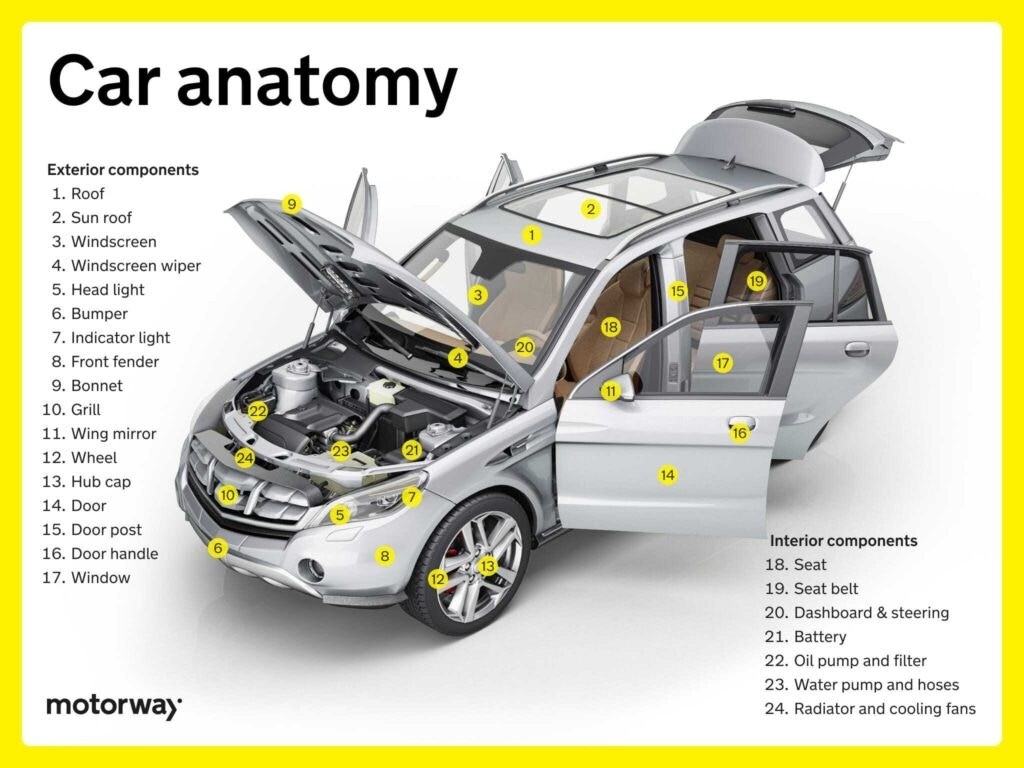
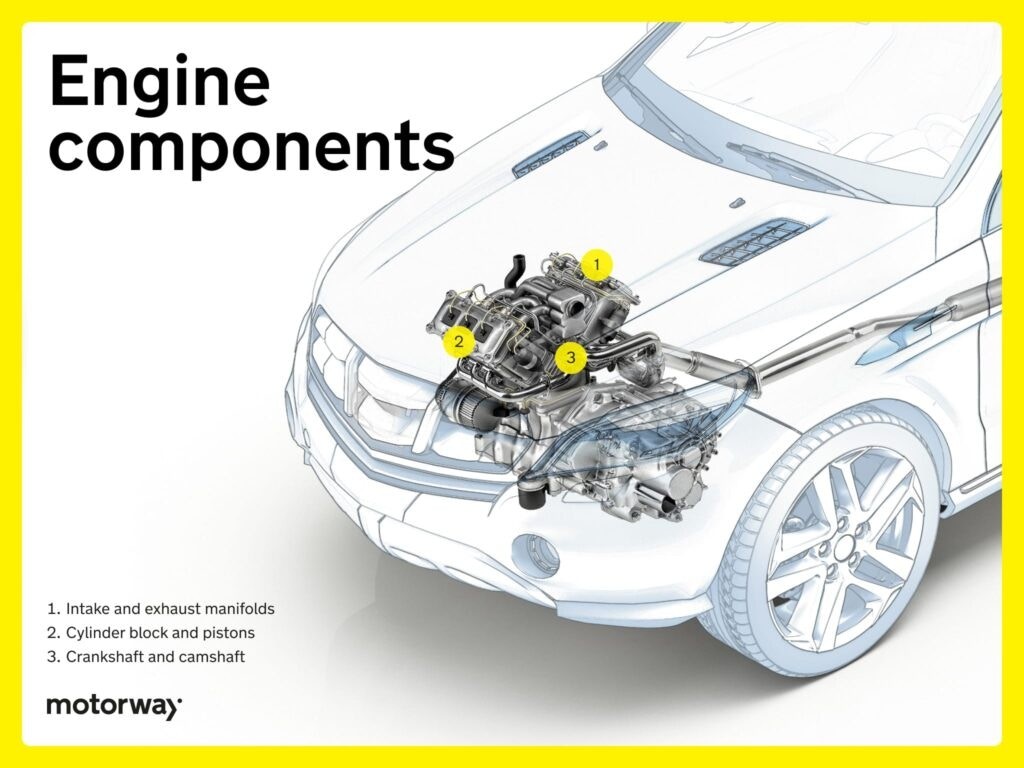
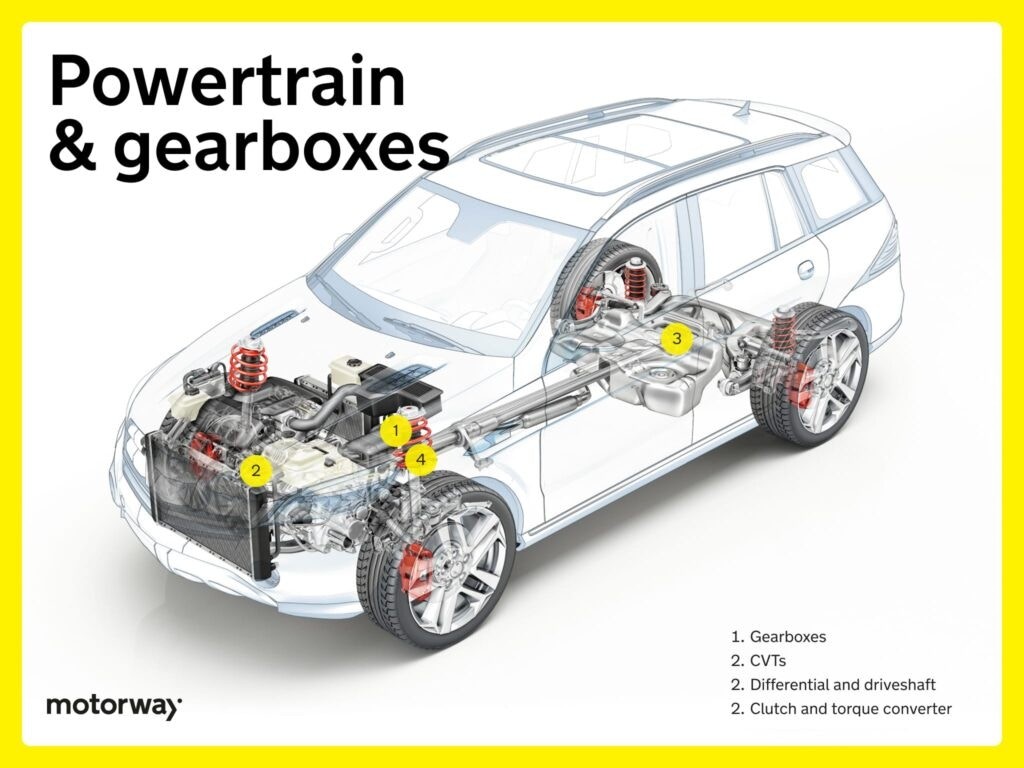

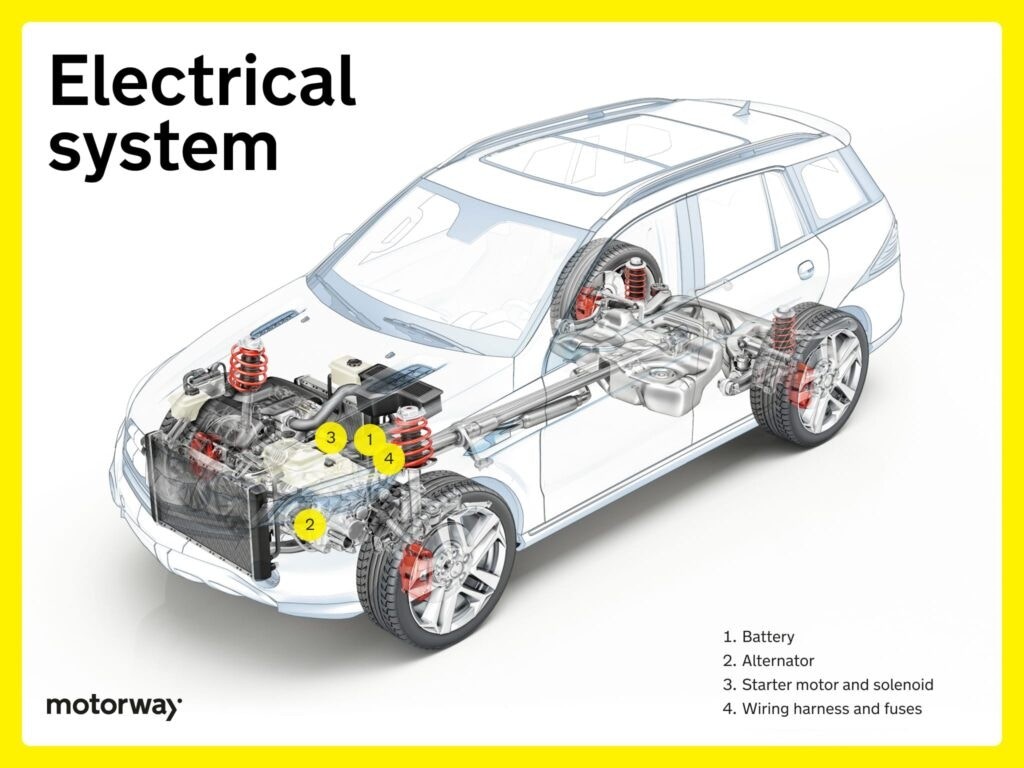

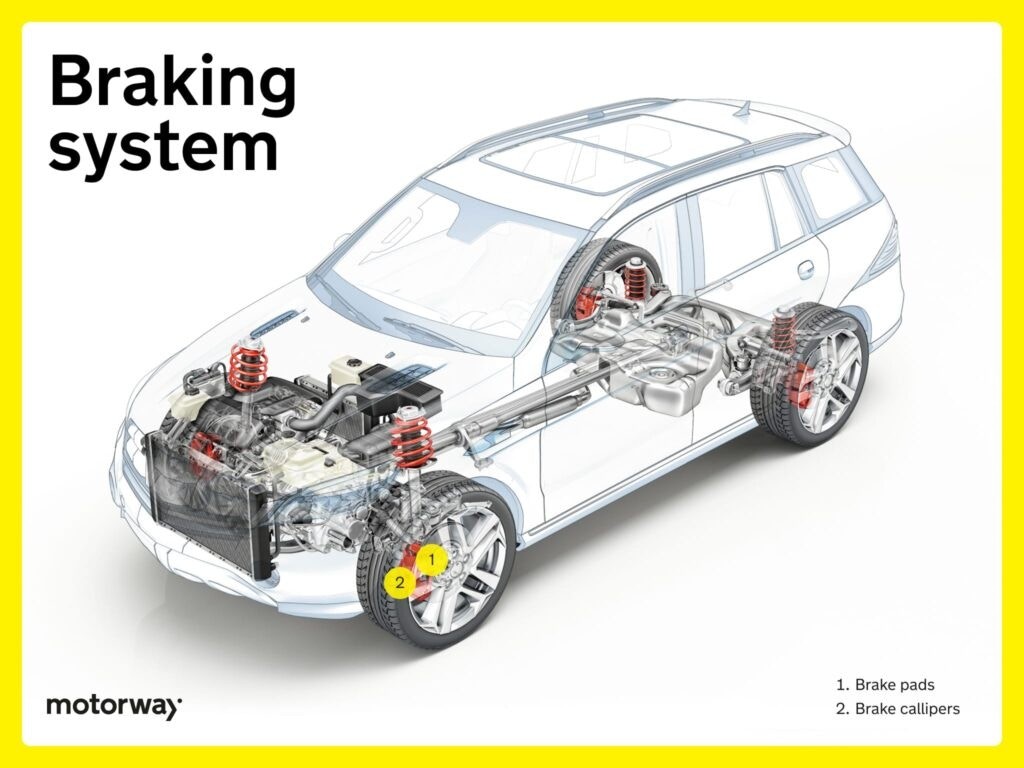
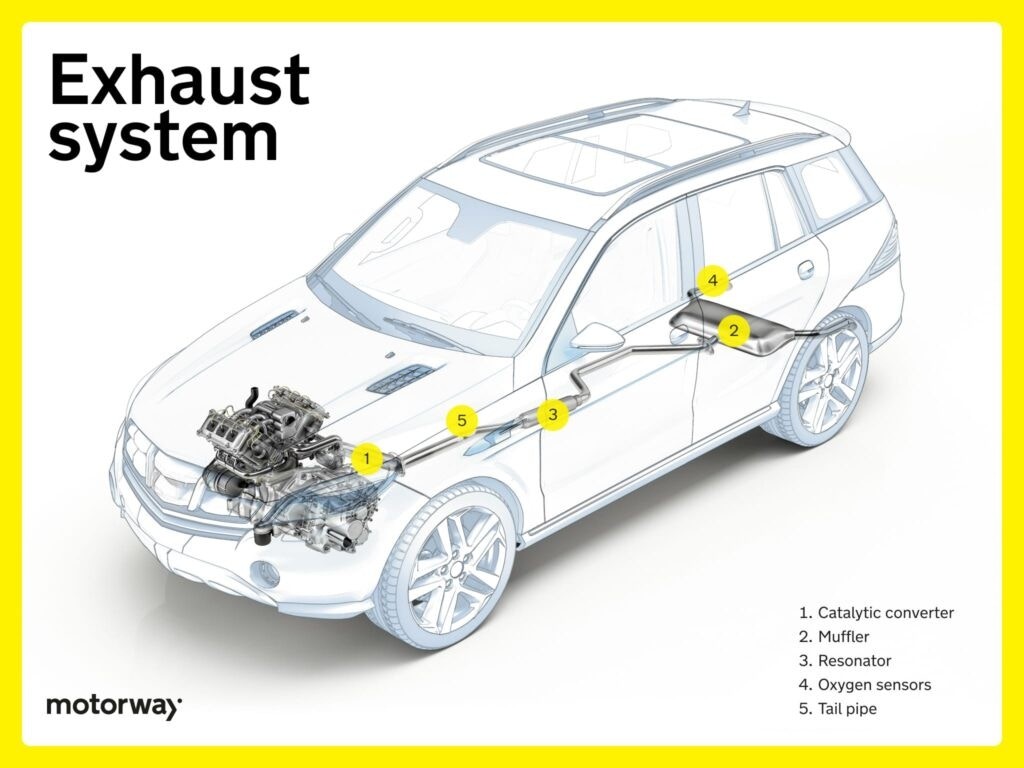
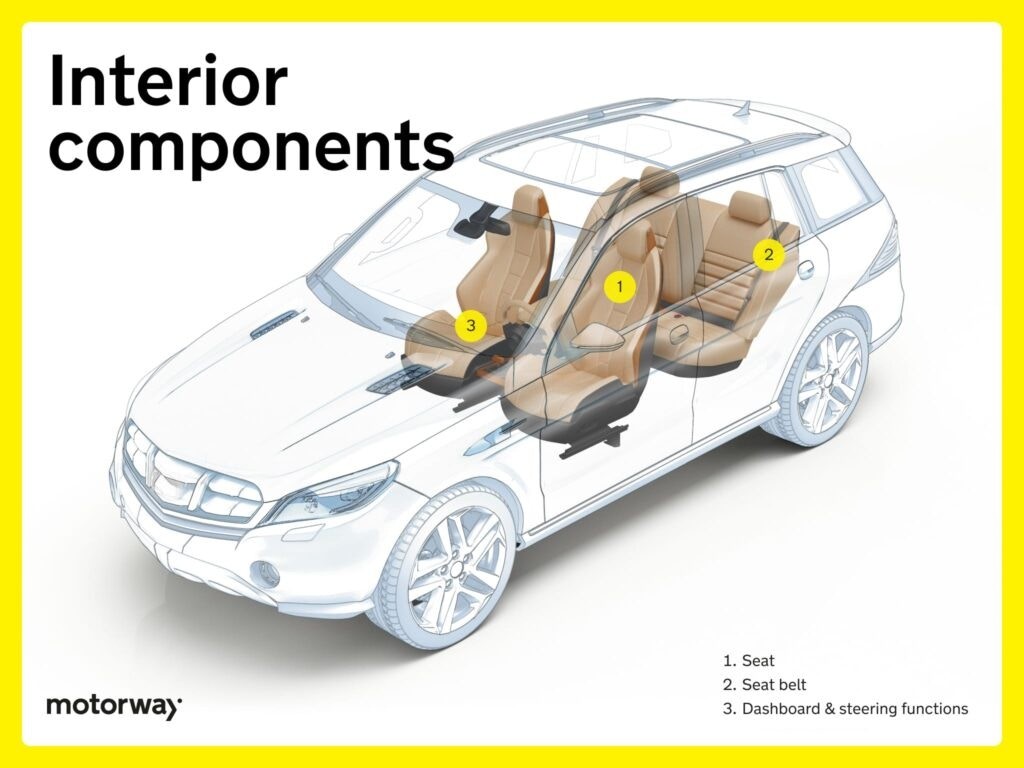
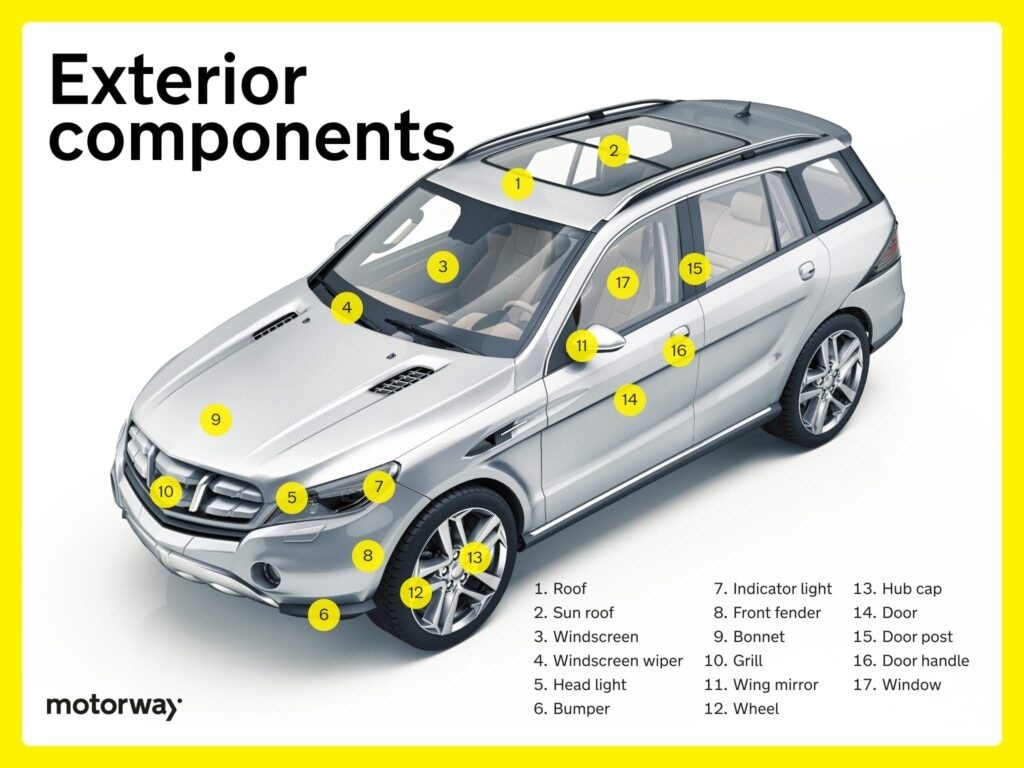
Wheel Construction Guide: Alloy vs. Steel Wheels
Wheel construction influences wheel weight, strength, and aesthetics. Common constructions include:
- One-piece construction: Made from a single piece of material, common for both alloy and steel wheels, offering simplicity and strength.
- Two-piece construction: Composed of two parts, the center and rim, often bolted or welded, found in performance and custom wheels for design flexibility.
- Three-piece construction: Modular design with three pieces (center, outer rim, inner hoop), allowing extensive customization, popular in aftermarket wheels for bespoke designs.
- Forged construction: Made from compressed metal under high pressure, resulting in lighter and stronger wheels, used in high-performance and racing applications for maximum strength and weight reduction.
- Multi-piece construction: Combines multiple components for versatility in size and customization, offering design and fitment flexibility.
Material choices also impact wheel characteristics:
- Alloy wheels: Made from aluminum or magnesium alloys, lightweight for better handling and heat dissipation, enhancing vehicle appearance with various designs.
- Steel wheels: Constructed from steel, robust and durable, heavier but cost-effective and suitable for rugged conditions, prioritizing strength and affordability.
Tyre Pressure Monitoring System (TPMS): Safety and Efficiency
The Tyre Pressure Monitoring System (TPMS) is a safety feature that continuously monitors tyre pressure. Sensors in each tyre transmit real-time pressure data to the vehicle’s computer. TPMS alerts the driver if tyre pressure drops below optimal levels. Maintaining correct tyre pressure improves safety, fuel efficiency, tyre life, and handling.
FAQs About Car Parts
What parts are under a car?
Beneath a car, you’ll find essential components like the engine, transmission, suspension system, exhaust system, and fuel system. These systems work together to ensure the car’s functionality and performance, housed within the undercarriage of the vehicle.
How many car parts are on a car?
The number of parts in a car varies, but modern vehicles can contain over 30,000 individual parts, encompassing numerous systems and components. This reflects the complexity of automotive engineering. Electric vehicles typically have fewer parts due to their simpler powertrains, relying on batteries and electric motors instead of complex mechanical systems.
What are the important parts of a vehicle?
Key vehicle parts include the engine, transmission, braking system, steering system, suspension, and electrical components. Each of these systems is vital for safe and reliable vehicle operation, contributing to overall vehicle safety and performance.
What parts of a car can be sold separately?
Individual car parts such as engines, transmissions, body panels, and specific electrical components can be sold separately in the aftermarket. The demand and availability of these parts depend on vehicle models and market needs, providing options for repairs, replacements, and vehicle customization.
Why is there a shortage of car parts?
Car part shortages can occur due to various factors, including supply chain disruptions, increased demand for specific parts, manufacturing challenges, and global events affecting production and distribution networks. These factors can impact the availability of parts and lead to delays in vehicle repairs and production.
Ready to Sell Your Car?
Want to discover more about car ownership, maintenance, or even selling your vehicle? Explore our extensive guides here, covering topics from Clean Air Zones to car tax and vehicle registration changes.